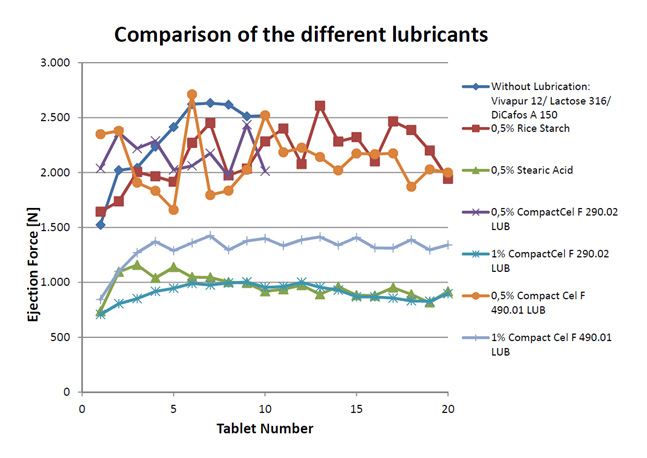Due to the fact that natural ingredients in dietary supplements are becoming more and more popular with the end consumer, the industry has to respond to this demand and look for new natural substitutes. In this way, the list of ingredients can be changed from synthetic substances to natural ones. The following data shows a comparison between conventional lubricants (stearic acid / magnesium stearate) and natural based lubricants (rice extract) or excipient premixes (cellulose/rice extract/oil/wax). By working with natural ingredients it would be possible to label your product cleaner than other chemical-sounding words.
The natural lubricant which was used for trials is a vegetable rice extract from RIBUS, a manufacturer of specialty ingredients. Nu-RICE® is a patented hypoallergenic extract from rice bran. This natural processing aid helps hydrate, lubricate and emulsify ingredients to create easier and faster processing.
Rice extract has light lubricant properties, additional ingredients can be used to increase the efficiency of the lubricant. Therefore an excipient premix of cellulose, oil, wax and vegetable rice extract (Nu-RICE®) from BIOGRUND was used for the trials. CompactCel® LUB combines the properties of a dry binder and lubricant. It’s a homogeneous dry milled powder compound.
All trials were performed on Romaco Kilian’s tableting robot STYL’ONE Evolution. It is predestined for a broad array of R&D applications and for producing very small batch sizes. With a maximum output of 1200 tablets per hour, this single-stroke press processes mono-layer, multilayer or core tablets (tab in tab).
To measure the lubricant effect, the preparation of the tablet mass were performed as follows:
Tablet mass basis mixture:
49,5% Microcrystalline cellulose
30,0% Lactose
20,0% Dicalcium phosphate
Trial 1: without lubrication
Trial 2: Rice extract 0,5%
Trial 3: Compact Cel® 490.01 LUB 0,5% and 1%
Trial 4: Compact Cel® 290.02 LUB 0,5% and 1%
Trial 5: Stearic acid 0,5%
Before the tableting process started all tablet mass mixtures were mixed for 15 minutes.
Only 49% microcrystalline cellulose were used in the tablet mass mixtures for the 1% CompactCel® formulations in trial 3 and 4.

Outcome
The most interesting data in this study is the ejection force. Starting on a scale from 0 N (for best lubrication effect) up to over 2500 N (for worst lubrication effect).
Best lubrication results were achieved by using only stearic acid as a lubricant. The measured ejection forces of the performed trials show that CompactCel® LUB premixes, based on natural ingredients, show comparable results when they are used as an alternative lubricant to stearic acid.
Beside this study another comparison was done were magnesium stearate instead of stearic acid was compared with the alternative natural lubricants. The results achieved comparable effects as shown in the figure above.




